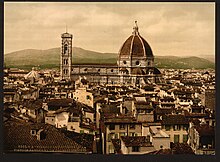| Gherardini of Montagliari (Florence) | |
|---|---|
 The coat of arms of the Gherardini of Montagliari in Tuscany, Patrician of Venice, Marquises of San Polo d'Enza, Marquises of Castelnuovo de' Gherardini, Marquises of Bazzano, Scurano and Pianzo, Patricians of Reggio in the Emilia region. | |
| Current region | Lazio, Tuscany |
| Place of origin | Tuscany |
| Founded | 856 |
| Connected families | House of Amidei House of Medici House of Strozzi House of Bardi House of Albizzi House of Altoviti |
| Motto | "Festina Lente" |
| Cadet branches | Gherardini of Tuscany Gherardini of Veneto Gherardini of Paris Gherardini of Ireland Gard Fitzgerald |


The Gherardini family of Montagliari (or Florence) was one of the most prominent historical Italian noble families from Tuscany, Italy. Through the Amideis, the family was of Roman descent.[1] Between the 9th and 14th centuries, they played an important role in Tuscany. Its influence was also felt in the Veneto and Emilia regions between the 16th and 18th centuries, and during the Italian Risorgimento as well as in today's Italian politics and economy.[2] The family's restless and fighting nature has aroused the curiosity of many historians of the Middle Ages. Originating from feudal tradition, it was one of the founding families of the Republic of Florence.[3]

The family took part in Florence's political life between 1100 and 1300. In 1300, they were exiled from the city when Florence began its transformation into a Signoria, later ruled by the Medicis. In his Divine Comedy, Dante Alighieri, who was exiled with the Gherardinis, placed the family in Paradise's V Sphere. Following its exile from Tuscany, the family joined the Great Council of Venice (Venice's Chamber of Peers), becoming Patricians of that city, and members of the Venetian nobility.[4] Until 1800, they kept some fiefs between Tuscany and Emilia Romagna.
The oldest knightly tomb in Tuscany (in the Church of Sant'Appiano, near Barberino Val d'Elsa) belongs to this family.[5] Historically influential in Florence, the Gheradinis were also featured in Florentine Histories, a book written by Niccolò Machiavelli at the request of the Medicis.[6] In modern times, their name is affiliated with the Mona Lisa of Leonardo da Vinci, as the painting depicts the portrait of Lisa Gherardini. Arms of this family is a quarterly Barry of six vair and gules and imperial eagles. Today's best known descendant lives in New York City and is an artist, Chiara Ajkun.
The Gheradinis also married into other Renaissance families across the centuries such as the Medicis, Strozzis, Bardis, Albizzis, Altovitis, Frescobaldis, Albertis, Balestrieris, and Ricasolis.[7][8]
- ^ Ponsonby and Murphy (1879). The Journal of the Royal Historical and Archaeological Association of Ireland. Fourth series. Vol. IV. The Association of Ireland. pp. 263–264. Retrieved 29 September 2022.
- ^ Titles: Lords of Montagliari in Tuscany, Patrician of Venice, Marquises of San Polo d'Enza, Marquises of Castelnuovo de' Gherardini, Marquises of Bazzano, Scurano and Pianzo, Patricians of Reggio in the Emilia region. From the Register of Italian Nobility during the Kingdom of Italy edited by the Ministry of the Interior, 1930
- ^ See the most recent studies carried out by Enrico Faini (University of Firenze): Enrico Faini, "Uomini e famiglie nella Firenze consolare", Firenze 2009, p. 23
- ^ Participation in the Great Council was established on hereditary right, exclusive to the patrician families enrolled in the Golden Book of the Venetian nobility
- ^ Bernini, Nicola La lastra tombale di Gherarduccio dei Gherardini nella Pieve di Sant'Appiano, Commentari d'arte : rivista di critica e storia dell'arte : 42/43, 1/2, 2009, - De Luca Editori d'Arte, p. 45-53
- ^ Niccolò Machiavelli (1532). The History of Florence and of the Affairs of Italy: From the Earliest Times to the Death of Lorenzo the Magnificent : Together with The Prince, and Various Historical Tract. G. Bell. pp. 50–67–72–81. Retrieved 30 September 2022.
- ^ Ponsonby and Murphy (1879). The Journal of the Royal Historical and Archaeological Association of Ireland. Fourth series. Vol. IV. The Association of Ireland. p. 258. Retrieved 29 September 2022.
- ^ Mona Lisa descendant just grins and bears it